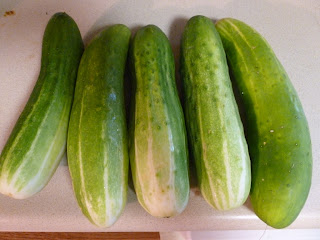Way back when we were buying seeds, we bought (or already had on hand) seeds for cantaloupe, butternut squash and cucumbers. The plan was to find a place in the lawn to dig out the sod and put in a vine patch. But with all the other work that we were doing on our raised beds, we simply never found the time to set this space up. Eventually we mounded up three hills in the very back section of the lot and planted seeds for those three plants, thinking at least giving them a try was better than not having it perfect. It seemed like a good plan.
Which it was, in theory. The trouble was that reality didn't agree much. The back of the yard was the former owners' garden area, and for whatever reason, has really bad soil. Maybe it was very intensively planted and never rebuilt with compost or organic matter, but it's never been able to hold moisture very well. So we should have been watering the plants pretty regularly, but for the second issue. We bought over 200 ft of hose, but even that doesn't quite reach the hills. When we'd irrigate, we'd have to get as close as we could and shoot the water up in a big arc, just barely reaching the plants. Probably not the best way to water. Add in frequent rabbit attacks, and by time the big drought came along this summer, it was an easy decision to just let these plants go and prioritize our water elsewhere.
Which was fine, except it meant we didn't have any of these:
And that's where the generosity of our fellow Iowans comes into play. A coworker of Stacia's had way more cucumbers than he could eat, and knew that we were into eating local, healthy produce. So he offered up a batch from his garden. The next week, one of Greg's coworkers had extra cucumbers and brought those into the office to share. Before we knew it, we had a pile of cukes we needed to use!
Some went into cucumber salad, others onto Chicago-style hot dogs, but we were still left with plenty, mostly the bigger, seedier specimens that didn't look as good for fresh use. We knew we couldn't let these go to waste, so we dusted off our trusty canner and took a look at the incomparable Ball Blue Book for a recipe. We settled on Dill Relish, since it wouldn't use the big seeds these particular cucumbers had, and well, because we like hot dogs.
The first step was to get rid of those seedy centers. This was easy enough; just slice down the center and use a spoon to scoop out the centers. You'll notice we also peeled ours since they were pretty big and had tougher skins. With thinner skinned cucumbers, you probably could leave them on.
From there, we just followed the step-by-step instructions in the Blue Book. We've mentioned this before, but it's worth repeating that following the Blue Book is a really good way to go when home canning. Doing it wrong can make you very sick (or worse), so we tend to trust the experts. To make relish we started by finely chopping the cucumbers in a food processor. This was a bit tricky - we had to use very short pulses to make sure we were chopping and not pureeing them to mush. After this we sprinkled the chopped cukes with the prescribed amounts of salt and turmeric, then covered the mixture with water and let it stand for 2 hours.

It didn't look bad, but it wasn't particularly appetizing at this point. Not much changed over the course of the few hours, at least not visually. But we faithfully let it sit this way for a few hours before we drained the liquid off the cucumber solids. This was a good start, but it needed some seasoning to become actual relish. The recipe from Ball called for chopped onions, sugar, white wine vinegar and dill seed. Note that dill seed is not the same as dill weed, and they apparently have a very different flavor. We originally thought we could use the dill weed in our cupboard but had to run out to get a bottle of dill seed at the last minute. We cooked this all together for 10 minutes.

After 10 minutes, it was starting to look more like relish. Still mostly cucumbers but with enough spice, vinegar and chunks of onion that we felt pretty confident it would be tasty. Because of that vinegar the relish was acidic enough that it could be processed in a boiling water canner, not a pressure canner. We had started with about 5 pounds of cucumbers and ended up with 4 nearly full pint jars. Each one sealed with a nice audible POP! but we left them on the counter with the rings on until the next morning. Then we gently pressed on the jar lid to make sure it was sealed and we threaded the rings off. When they were done, they looked like this:

We haven't had any hot dogs since we made these jars of relish, so we actually have no idea how good or not good it might taste. Thus far everything we've made from the Ball Blue Book has been delicious so there's no reason to think that this will be any different. Either way, it was a great way to use someone's excess cucumbers. We did what we could to enjoy the fresh veggies when they were in season, but that time can be pretty fleeting. Canning is a great way to preserve the harvest for later, even if it's not our harvest.












